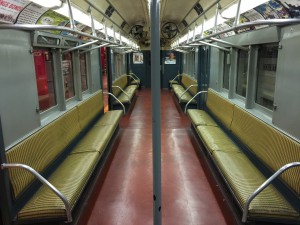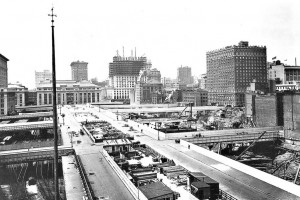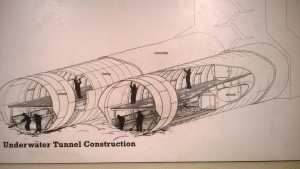Visiting the NYC Transit Museum and the Archives was a great experience and definitely one I found Interesting. Firstly, it was amazing looking through old photographs of the city back in the early 1900’s, particularly Bryant Park and Times Square. In the Bryant Park photos, it was interesting to see the place wide and open as oppose to it being surrounded by buildings today. On the top right corner of one photo, you could see advertisements for the Barnum and Bailey circus and even more incredible what looked like a Wrigley’s spearmint gum ad, both of which are still around to this day. With Times Square, you could still see how it was a place that got crowded even back then. Also, The bottom of that one building where the New Years ball drops could still be seen. Lastly, out of the many more things we saw in those photos, the one thing that stood out in all of them was the clothing people wore.
Inside the Transit Museum, I enjoyed seeing how the subways and tunnels were made. The various photos and displays of the tools used painted a good picture of what it must have been like back then. Specifically, they had this one mock up of a wheelbarrow with actual rocks in it that weighed about half of what workers back then typically moved; The purpose of it was to try to lift it so you could see how much hard work was put in back then. Looking at the different variations of turnstiles over the years was cool too. Something new I learned was that back when they used tokens to pay for the subway, they had something called ‘slugs’ which was a term used to describe counterfeit tokens. By far, the thing that caught my attention the most was looking at and actually stepping into the old trains found on the lower level of the museum. From the outside, not much but the paint job and style of display changed over the years. The more interesting stuff was found inside. Things like old advertisements, signs, and fans were interesting to look at; the seats were what made the display amazing. What was funny about them was how they were more comfortable back then, with the cushioned seats and all, and how they slowly came to be the uncomfortable ones we have now.

New York Central System. (1970). Grand Central Terminal [Brochure]. New York, NY: Author. This pamphlet/brochure contains information about Grand Central Terminal such as a brief overview of its history, current events located there, and more. Meant for those visiting New York, specifically the Terminal, it shows old photographs of Grand Central dating back to circa 1970 along with short captions detailing the place’s significance.
The Gateway to a Continent. (1940). New York, NY: New York City Architects. A book containing information about various hotels in NYC during the 1940’s. Composed of brief description of each hotel including details such as, the location, nearby structures along with photographs and draws of them.








